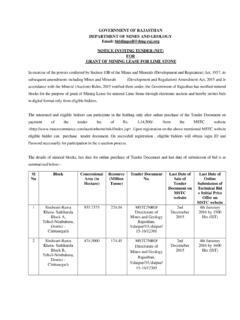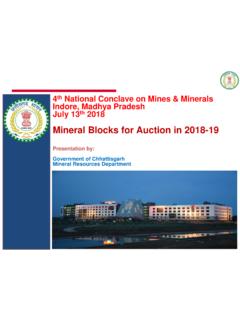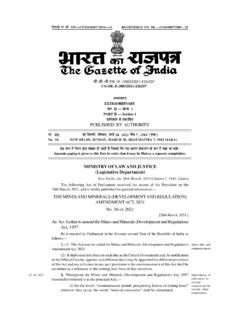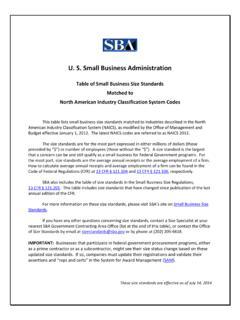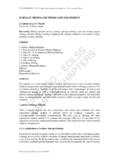Transcription of E-BOOK ON MINING SECTOR - Ministry of Mines Home
1 E-BOOK . ON. MINING SECTOR . CONTENTS. Nos. Details Pages Introduction 01-01. Structure of Minerals and MINING SECTOR 02-03. Role of MINING SECTOR in Indian Economy 03-06. Legislative Framework for MINING SECTOR 06-12. Initiatives/New Development for MINING SECTOR 12-17. Mineral Administration 17-18. Mineral Regulation 18-19. Taxation and Royalties 19-21. Present Status of Exploration with Mineral Assets 21-30. Distribution of MINING Leases in the Country 30-32. Mineral Production 32-36. Consumption of Minerals and Mineral Based Industries 36-39. Foreign Trades 39-41. 1. ANNEXURES. Nos. Details Pages I Production of Selected Minerals, 2010-11 to 2014-15 (E) 42. II Mineral wise no. of Reporting Mines for MCDR Minerals, 2009-10 to 44.
2 2013-14 (P). III (A) State wise Average Daily Employment, 2011-12 to 2013-14 (P) 46. III (B) Mineral wise Average Daily Employment, 2011-12 to 2013-14 (P) 47. IV (A) Contribution and Rank of India in World Production of Principal Minerals 49. & Metals, 2013. IV (B) Degree of Self Sufficiency in Principal Minerals & Metals, 2013-14 (P) 50. V Mineral wise reserves/resources as on *2013 51. VI (A) State wise Summary of MINING Lease distribution as on 55. VI (B) Mineral wise Summary of MINING Lease distribution as on 56. VII Mineral wise production & Value, 2009-10 to 2013-14 (P) 58. VIII Consumption of Important Minerals, 2011-12 to 2013-14 (P) 59. IX (A) Exports of Ores & Minerals, 2010-11 to 2014-15 (P) 60. IX (B) Exports of Metals & Alloys, 2010-11 to 2014-15 (P) 62.
3 X (A) Imports of Ores & Minerals, 2010-11 to 2014-15 (P) 63. X (B) Imports of Metals & Alloys, 2010-11 to 2014-15 (P) 66. 2. INTRODUCTION. It is a well known ecological fact that the best known forests, river and ocean basins, and fertile landscapes are also rich below ground with natural resources such as fossil oils and minerals. MINING of underground natural resources do require giving up the rights and usufruct benefits of surface based natural resources. Added to this is the fact that the history of the world has seen a continual modification and mortification of the landscape of the earth both above and underground for anthropocentric purposes;. and most of such land conversions are irreversible. India has a total geographical area of about 328 million hectares.
4 Of this, the MINING lease (except than fuel, atomic and minor minerals) area as on , constitutes around percent. The Indian sub-soils are rich in onshore and off shore crude oils and gas, coal, iron ore, copper, bauxite, etc. Of all variety of land use categories, the common lands consisting of forest lands, pasture lands, and current fallow and cultural waste lands dominate. Minerals are valuable natural resources that are finite and non-renewable. They constitute the vital raw materials for many basic industries and are a major resource for development. The history of mineral extraction in India dates back to the days of the Harappan civilization. The wide availability of minerals in the form of abundant rich reserves and the eco-geological conditions make it very conducive for the growth and development of the MINING SECTOR in India.
5 As a major resource for development the extraction and management of minerals has to be integrated into the overall strategy of the country s economic development. The exploitation of minerals has to be guided by long-term national goals and perspectives. Thus, minerals play a key role in the evolution of human society and the development of leading economics. MINING SECTOR , being one of the core SECTOR of economy, provides basic raw materials to many important industries like power generation (thermal), iron and steel, cement, petroleum and natural gas, petro-chemicals, fertilisers, precious & semi-precious metals/stones, electrical & electronics equipment, glass and ceramics etc. India produces as many as 88 minerals which includes 4 fuels minerals, 3 atomic minerals, 26 metallic & non-metallic minerals and 55 minor minerals (including building and other materials).
6 There will be huge demand for minerals in view of the rapid urbanization and growth in the manufacturing SECTOR in India. India occupies a dominant position in the production of many minerals across the globe. 3. STRUCTURE OF MINERALS AND MINING SECTOR . The Ministry of Mines (MoM), Government of India is responsible for the entire minerals and MINING SECTOR in the country that includes legislation, administration, policy formulation etc. in respect of all Mines and minerals other than coal and lignite, natural gas and petroleum, but including offshore minerals. In the case of atomic minerals and coal activities of the Ministry are limited to regional exploration. In India, the minerals are classified as minor minerals and major minerals.
7 The power to frame policy and legislation relating to minor minerals is entirely delegated to the State Governments while policy and legislation relating to the major minerals is dealt by the MoM. The Ministry is responsible for the administration of the Mines and Minerals (Development and Regulation) Act, 1957. and rules made there under in respect of all Mines and minerals other than coal, natural gas and petroleum. MoM through its attached office, Geological Survey of India (GSI), facilitates exploration, geological mapping and mineral resource assessment in the country. Indian Bureau of Mines (IBM), a subordinate office of the MoM is mainly responsible for regulation of MINING in the country. The Ministry also administers the Offshore Areas Mineral (Development and Regulation) Act, 2002 and rules made there under.
8 Mineral concessions in India are granted to Indian nationals or entities incorporated in India only. Subjects allocated to Ministry of Mines (a) Legislation for regulation of Mines and development of minerals within the territory of India, including Mines and minerals underlying the ocean within the territorial waters or the continental shelf, or the exclusive economic zone and other maritime zones of India as may be specified, from time to time by or under any law made by Parliament. (b) Regulation of Mines and development of minerals other than coal, lignite and sand for stowing and any other mineral declared as prescribed substances for the purpose of the Atomic Energy Act, 1962 (33. of 1962) under the control of the Union as declared by law, including questions concerning regulation and development of minerals in various States and the matters connected therewith or incidental thereto.
9 (c) All other metals and minerals not specifically allotted to any other Ministry / Department, such as aluminium, zinc, copper, gold, diamonds, lead and nickel. (d) Planning, development and control of, and assistance to, all industries dealt with by the Ministry . (e) Administration and management of Geological Survey of India. (f) Administration and management of Indian Bureau of Mines . (g) Metallurgical Grade silicon 4. Attached Office / Subordinate Office: Geological Survey of India (Headquarters at Kolkata) is an attached office and Indian Bureau of Mines (Headquarters at Nagpur) is a subordinate office of the Ministry . Public SECTOR Undertakings: There are three Public SECTOR Undertakings under the Ministry of Mines , namely:- National Aluminium Company Limited (NALCO), Bhubaneswar Hindustan Copper Limited (HCL), Kolkata Mineral Exploration Corporation Limited (MECL), Nagpur Autonomous Bodies There are three Research Institutions which are Autonomous Bodies of this Ministry : Jawaharlal Nehru Aluminium Research Development and Design Centre (JNARDDC), Nagpur.
10 National Institute of Rock Mechanics (NIRM), Kolar Gold Fields, Karnataka, and National Institute of Miners Health (NIMH), Nagpur. ROLE OF MINING SECTOR IN INDIAN ECONOMY. MINING is one of the core sectors that drive growth in an economy. Not only does it contribute to GDP, it also acts as a catalyst for the growth of other core industries like power, steel, cement, etc., which, in turn, are critical for the overall development of the economy. Thus, MINING SECTOR is playing a critical role in the economic development, attracting investment and generating employment in the country. MINING SECTOR provides basic raw materials to many important industries like (thermal) power generation, iron and steel, cement, petroleum and natural gas, petro-chemicals, fertilisers, precious and semiprecious metals and stones, electrical and electronic equipments, glass and ceramics etc.

